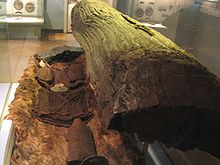Egtved Girl
Egtved Girl | |
|---|---|
 Treetrunk coffin of the Egtved Girl at the National Museum of Denmark | |
| Born | c. 1390 BC |
| Died | c. 1370 BC (aged 16-18) |
| Body discovered | 24 February 1921 |
| Resting place | National Museum of Denmark, Copenhagen, Denmark |
| Era | Nordic Bronze Age |
| Known for | Her well-preserved remains |
| Height | 160 cm (5 ft 3 in) |
The Egtved Girl [ˈektveð] (c. 1390 – c. 1370 BC) was a Nordic Bronze Age girl whose well-preserved remains were discovered outside Egtved, Denmark in 1921. Aged 16–18 at death, she was slim, 160 centimetres (63 in) tall, had short, blond hair and well-trimmed nails. Her burial has been dated by dendrochronology to 1370 BC. She was discovered together with cremated remains of a child in a barrow approximately 30 metres (98 ft) wide and 4 metres (13 ft) high. Only the girl's hair, brain, teeth, nails, and a little of her skin remain preserved.
Burial

The barrow was excavated in 1921, and a coffin was found in an east-west alignment. It was sealed and transported to the National Museum of Denmark in Copenhagen, where it was opened, revealing the Egtved Girl.
In the coffin, the girl was wrapped in an ox hide. She wore a loose, short tunic with sleeves reaching the elbow. She had a bare waist and wore a short string skirt. She had bronze bracelets, and a woollen belt with a large disc decorated with spirals and a spike. At her feet were the cremated remains of a child aged 5 to 6. By her head, there was a small birch bark box that contained an awl, bronze pins, and a hair net.
Before the coffin was closed, she was covered with a blanket and an ox hide. Flowering yarrow (indicating a summer burial) and a bucket of beer made of wheat, honey, bog-myrtle, and cowberries were placed atop. Her distinctive outfit, which caused a sensation when it was unearthed in the 1920s, is the best-preserved example of a style now known to be common in northern Europe during the Bronze Age. The good preservation of the Egtved Girl is due to the acidic bog conditions of the soil, which is a common condition of this locale.
Reconstruction
The outfit was reconstructed for the National Museum of Denmark by the Lejre Experimental Centre and is on display there. A reconstructed set of clothes, as well as details of the excavation, are on display in the Egtved Girl's museum at the excavation site.
Origin and life
Initial work by Frei et al in 2015, since contradicted, examined chemical isotopes of strontium from the Egtved Girl's teeth, fingernails, hair, and clothing, and based on these, proposed that she had likely come from the Black Forest region of Germany, but married and moved to Denmark, subsequently traveling back and forth between the two areas.
However, Thomsen and Andreasen demonstrated in 2019 that the strontium isotopic data obtained from the area surrounding the grave and used by Frei et al for comparison against the remains had been contaminated by additional strontium contained in the agricultural lime used in modern farming in the Egtved area. When Thomsen and Andreasen analyzed samples locally from places uncontaminated by modern farming, they found that the range of strontium isotopic values in the surrounding natural environment matched those in the girl. Thus, it is most plausible that she originated from and spent her entire life in the Egtved area, and did not come far abroad, as proposed by Frei et al. Thomsen and Andreasen's results show that the girl did live about half the year in one area – likely the river valley in Egtved – and the other half of the year in another place – likely the local plateau, perhaps in the practice of transhumance farming and seasonal pastoral movement within a small area.
In a 2019 article based on strontium isotope analysis, Sophie Bergerbrant suggests an origin of Sweden or Norway for the Egtved Girl.
Gallery
-
Replica of the Egtved Girl's outfit
-
Remains of the Egtved Girl
-
The reconstructed barrow
-
Egtved Girl's museum
-
Bronze beltplate
-
Clothes
-
Burial mound
See also
Citations
- ^ Hair fashion of the Bronze age National Museum of Denmark. Retrieved 17.11.2011.
- ^ "Prehistoric period (until 1050 AD)". Oldtiden.natmus.dk. Nationalmuseet. Archived from the original on 2011-06-12. Retrieved 2011-12-08.
- ^ "Remains of Bronze-Age Cultic Priestess Hold Surprise". LiveScience. May 21, 2015. Retrieved 2015-05-31.
The girl's final resting place was first unearthed in 1921, in a large burial mound made of peat bog.
- ^ Frei, Karin Margarita; Mannering, Ulla; Kristiansen, Kristian; Allentoft, Morten E.; Wilson, Andrew S.; Skals, Irene; Tridico, Silvana; Louise Nosch, Marie; Willerslev, Eske; Clarke, Leon; Frei, Robert (21 May 2015). "Tracing the dynamic life story of a Bronze Age Female". Scientific Reports. 5 (1): 10431. Bibcode:2015NatSR...510431M. doi:10.1038/srep10431. PMC 4440039. PMID 25994525.
- ^ Thomsen, Erik; Andreasen, Rasmus (13 March 2019). "Agricultural lime disturbs natural strontium isotope variations: Implications for provenance and migration studies". Science Advances. 5 (3): eaav8083. Bibcode:2019SciA....5.8083T. doi:10.1126/sciadv.aav8083. PMC 6415960. PMID 30891501.
- ^ Bergebrant, Sophie (2019). "Revisiting the Egtved Girl". Gothenburg University library website. NTNU Vitenskapsmuseet, Institutt for arkeologi og kulturhistorie og Museumsforlaget. Retrieved 2019-11-17.
References
- Barber, E. W. The Mummies of Ürümchi. Macmillan, London, 1999. ISBN 0-393-04521-8.
- Hogan, C. Michael, "Girl Barrow", The Megalithic Portal, editor A. Burnham, 4 October 2007
- Michaelsen, K. K. Politikens bog om Danmarks Oldtid. Politiken, Denmark, 2002. ISBN 87-00-69328-6.
External links
- The Egtved Girl on National Museum of Denmark website.






